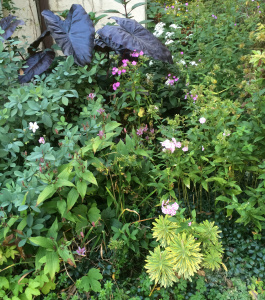
Colocasia ‘Black Magic’ in back of Phlox ‘Shortwood’, Eupatorium ‘Chocolate’, Euphorbia ‘Ascot Rainbow’
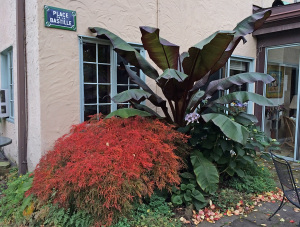
Large leaves of Ensete maurellii as contrast to delicate foliage of Acer palmatum dissectum ‘Viridis’ in part shade bed
Even though temperatures are fluctuating, I am still gardening. I was able to plant bulbs early this week and last without freezing to death. I’ve been mostly planting tulips since most of my other bulbs have naturalized. It’s also been time to move my tropicals, such as Colocasia and Xanthosoma (types of Elephant Ears) to the basement. The last one to come out of the garden was my Ensete maurellii, a non-hardy banana that is huge now because I’ve overwintered it five times.
In the world of landscape design, one is never done because the garden evolves. This week I’ve finally been able to act on some thoughts that I’ve had about the garden. For instance, I’ve had Thalictrum orientale for a number of years. The foliage is quite delicate as are the blossoms and it remains attractive long after it finishes blooming. There are two giant problems, however. One, it seeds prolifically and my clump is already quite large even though it started out as a small plant. Two, it has very strong, mat forming roots so that when I try to weed it out of my fall blooming Aconitum, it is nearly impossible to do without destroying the Aconitum. Thus I decided that it had reached the end of its useful life. Then the question is: What will I plant in that space?
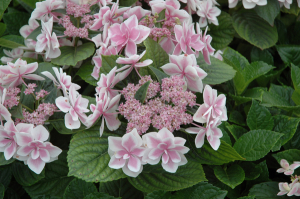
Hydrangea macrophylla ‘Stargazer’-erica-enterprises.com
It just so happens that I brought back a Hydrangea macrophylla ‘Stargazer’ from my trip to Klyn Nurseries and was searching for a spot in which to plant it. Ta-da!. It looks small and lonely right now but given a year or two, it will fill most of the space. The data suggests that ‘Stargazer does best in well-drained soils in part shade but will tolerate full sun if grown in consistently moist soils. Fortunately, this spot is near a drip hose for my hanging basket. The lacecap flowers have a picotee edge that is lighter than the inner two-thirds of the petals. Like most hydrangeas, it will be blue or pink depending on the ph of the soil. I know already that I will have to add aluminum sulfate in order to make the soil more acid and thus have blue flowers.

Chamaecyparis obtusa ‘GoldenWhorl’-bloomriver.com
While I have a lot of yellow foliage in my back gardens, I have very little in the front with the exception of Heucherella ‘Stoplight’. Its yellow foliage has a deep red blotch in the center that radiates out toward the edges. Partial shade is essential for this perennial. Without it, the leaves will burn. Mine is planted at the base of Hibiscus ‘Pinot Noir’ for a bit of color echo but you cannot see it from the sidewalk. Since I have so much yellow in the back, I decided that I need some in the front where I and passers by can actually see it. Again, while I was at Klyn Nurseries, Bill Hendricks showed me a Chamaecyparis obtusa ‘Golden Whorl’. I decided that was the perfect plant for the front of my center bed. It is very easy to misidentify this plant because it looks like a pisifera cultivar with its fingery foliage.
All of my old-fashioned mums are blooming now as are the Aconitum (Monkshood) and the very tall Aster tataricus ‘Jin Dai’. I love having perennials that bloom in October and November. If you would like that too, it can be arranged.


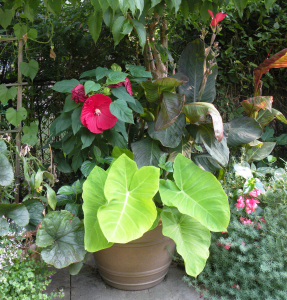
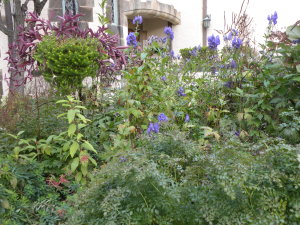
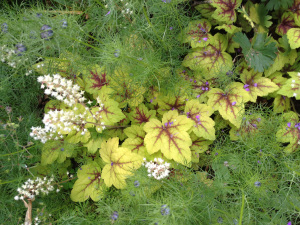
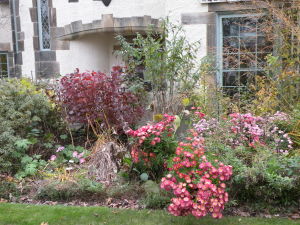
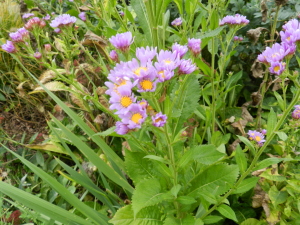
0 Comments